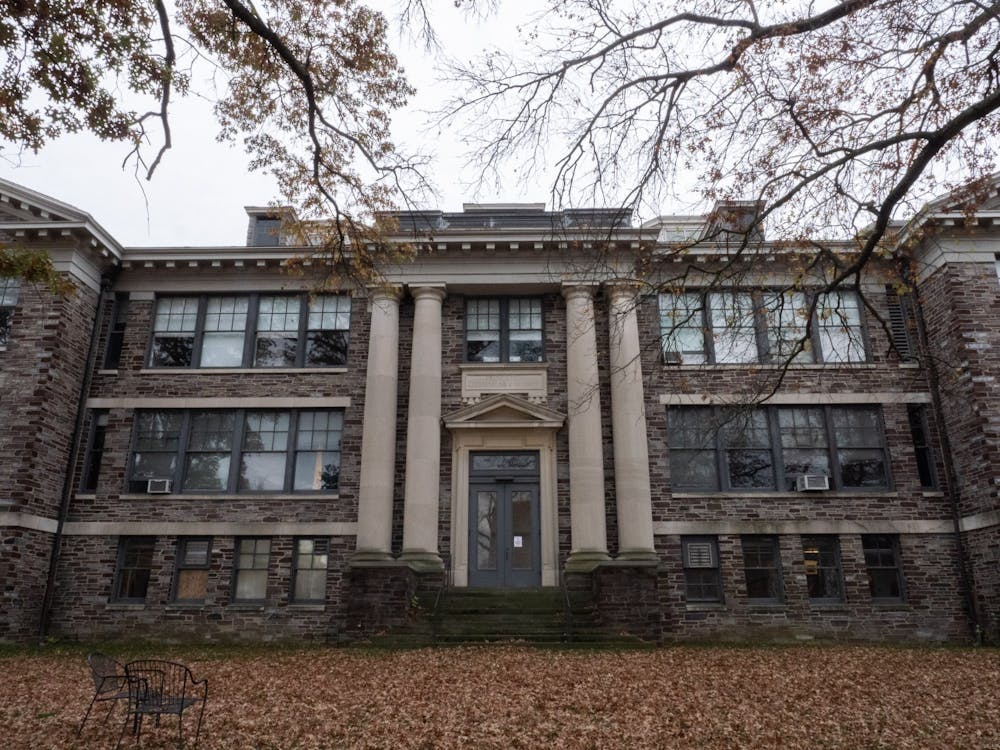On Nov. 3, visual arts professor Joe Scanlan said the n-word while posing a question to students during his VIS321: Words as Objects seminar. He used the word during a discussion about a poem by Black poet Jonah Mixon-Webster’s poetic anthology “Stereo(TYPE).”
Scanlan, who is white, is a tenured professor and artist with a history of racially charged art projects. In the classroom on Nov. 3, he used the n-word when asking students how the word functioned in the text. Multiple students in VIS321 told the The Daily Princetonian that Scalan’s use of the word was not a direct quote from the poem, but his own words.
Scanlan said he disagrees with the characterization that he didn’t cite Mixton-Webster. In an email to the ‘Prince,’ he wrote, “In fact I was citing his poem ‘Black Existentialism no. 8: Ad infinitum; Ad Naseum,’ which runs for almost 20 pages and consists entirely of one word, the n word, spelled with an ‘a’ instead of ‘er.’”
After Omar Farah ’23, a Black student in the class, raised an official complaint about the incident to the University, the Office of the Provost concluded that there had not been a violation of the Policy on Discrimination and/or Harassment following an initial assessment of the situation.
Farah is a Managing Editor for the ‘Prince’; they recused themself from the news coverage of this incident.
Following the use of the word, multiple students in the class told the ‘Prince’ they felt uncomfortable continuing to be taught by Scanlan, and some called for his firing.
David Smith ’24, a Black student in the class, told the ‘Prince’ that he believes Scanlan should be fired. “They can’t fire him for saying that word, but they can fire him for being incompetent and intentionally causing harm, of which I think he did both,” he said.
Smith is a social media staff member for the ‘Prince.’
After Scanlan asked the question during the class, Farah told the ‘Prince’ that there was “shock in the classroom” and some silence before they asked, “Are we really having a discussion where you can say that word?”
Scanlan responded with a defense that the word had ended in “-a” instead of “-er,” Farah and multiple other students in the seminar independently told the ‘Prince.’ After this exchange, Farah left the classroom.
According to multiple other students who remained, Scanlan continued to defend his choice to the class, saying that he felt the use of the word was necessary to have an academic conversation about the piece. A few other students also left before the end of the seminar.
Scanlan has been a professor at the University since 2009, and he formerly served as director of the Visual Arts Program from 2009–2017. He has previously faced public criticism for racially-charged art projects, for years, he created art under the guise of a fictional Black woman, a character he made up named Donelle Woolford. In 2003, Scanlan’s Paydirt exhibition included a self-portrait with what appeared to be brown paint or dirt on his face, which was criticized by some as blackface.

According to Scanlan, his Paydirt piece was made in Birmingham, England, “not [in] reference [to] blackface but the long history of social justice [photography] of working men, mostly coal miners and factory workers, with dirt on their faces.”
On the morning of Nov. 6, three days after the incident, Scanlan sent a message to his students via Canvas, writing that he “was trying to make a point about Jonah Mixon-Webster demonstrating the empowering effect of how a single word has gone through an alchemical transformation: coopted, materially reconfigured, and redeployed as concrete poetry.”
“I did that very badly and, in doing so, harmed you,” he wrote in the post. “I apologize profoundly for that.”
He continued, “I don’t expect you to forgive me, or even fully trust me from here on out, as that would be an understandable reaction. But I do hope we can continue working together through the end of the semester.”
Following the incident, Farah reached out to the Director of the Visual Arts Program, their residential college dean, and their academic advisor. Cheri Burgess, the Director for Institutional Equity and EEO for the Office of the Provost, in turn contacted Farah to discuss the incident on the afternoon of Friday, Nov. 4. Farah said they filed an initial complaint regarding the incident during the meeting.
On the evening of Monday, Nov. 7, Burgess followed up with Farah, writing in an email to them that “the vice provost has conducted an initial assessment of the information provided and has determined that, given the academic context in which the word was used, it does not implicate the Policy on Discrimination and/or Harassment.”
“While the word used was offensive, it was clearly within the context of academic freedom and, therefore, protected expression,” she wrote. “For these reasons, this office cannot initiate an investigation of your complaint.”
In the email, Burgess quoted the University’s Statement on Freedom of Expression, which states that “the University’s fundamental commitment is to the principle that debate or deliberation may not be suppressed because the ideas put forth are thought by some or even by most members of the University community to be offensive, unwise, immoral, or wrong-headed.”
Burgess also noted that “if the alleged conduct would not, even if substantiated, constitute a violation of applicable policies, then the complaint is dismissed from further review.”
“The dismissal of a complaint during the initial assessment is not subject to appeal,” she wrote to Farah.
Asked to comment on the incident, University Spokesperson Michael Hotchkiss wrote in a statement to the ‘Prince’ that “Princeton guarantees all faculty and students the ‘broadest possible latitude’ to speak freely inside and outside the classroom. Speech is only restricted under narrow exceptions that do not apply to this incident.”
“Our rules recognize that these free speech protections apply to words and ideas that people may find ‘offensive, unwise, immoral, or wrong-headed,’ but these protections are essential for Princeton’s truth-seeking mission,” Hotchkiss wrote.
After receiving the initial email from Burgess on Monday, Farah submitted another complaint online through the Discrimination/Harassment complaint form. In response, Burgess sent them a follow-up email.
“I understand that the determination of the initial assessment is disappointing to you,” she wrote. “The University’s policies guide how we evaluate claims of verbal harassment, especially when they intersect with the principles of free expression.”
Although the University maintains that its policies were not violated, Burgess noted in her initial email to Farah that “the department leadership is exploring ways to address the impact of this experience on you and the other affected students and to support your academic well-being.”
“It has been deemed that what Scanlan did was protected by freedom of speech and academic freedom,” Jeffrey Whetstone, Director and Professor of Visual Arts, wrote in a statement to the ‘Prince.’
“But still, students are wary of going back into the classroom. Some outright refuse to return. At least one has dropped the course. They also told me that they are afraid of grade retaliation,” he wrote. “We are trying to address that administratively and come up with a plan where students feel that they will be treated fairly and with respect.”
Whetstone said that “the racial slur used in Professor Scanlan’s ‘Words as Objects’ class has directly harmed students in that class” and also “others more indirectly — our faculty, staff, and other students — ones not even in the course.”
In Farah’s view, the course has been permanently compromised as a result of Scanlan’s speech.
“There’s no path forward for any of us in this course under his instruction,” Farah said. “It’s a difficult situation for all of us, because we’ve spent eight weeks now creating work for the class.”
On Nov. 10, the day of the next scheduled class, Scanlan announced to his students in a Canvas post that he would not be present at class time, which they could use as an open studio.
In his post, he wrote, “I suspect some of you are struggling with whether you want to come to class today, either because of my behavior or because it would suggest your acceptance of that behavior.”
“I want you to be able to continue working on your art while I work with VIS and the Lewis Center to see what arrangements we might make to help the class move forward. We would welcome your input in that regard,” he continued.
At least five students did not attend the seminar on Nov. 10.
“I went back before class started today and removed all my pieces from the classroom,” said Nathalie Charles ’25, a Black student in the seminar. “I don’t feel comfortable around Joe Scanlan.”
“I believe that Professor Scanlan should be fired,” she continued. “And I believe he should have been fired when he did blackface. When you do something as hurtful as using a racial slur in order to provoke students in your class to a certain end, you should face the consequences of that.”
When the ‘Prince’ asked Smith, one of the Black students in the class, if he was returning to class, he said, “No, absolutely not. I’m not gonna go at all.”
“I was assured by the [Visual Arts] administration that there would be some sort of arrangement figured out. I was assured not to drop the class,” Smith added.
Other students expressed that they were uncertain of whether they would return to the class.
“Dropping the class feels unfair to me because I’ve been producing work for it,” said Azariah Jones ’25, a Black student in the class. But if nothing changes, she said that she would “be conflicted about going to class and it would probably be a no.”
Grey Raber ’23, a white student in the seminar, said, “If Black students in the class feel uncomfortable returning, then I won’t.”
When asked what she would like to see moving forward, Jones said that she “would like an apology, a very sincere apology, and something that indicates that he understands the gravity of what happened.”
“I want him to understand what he did incorrectly,” she continued, “and for the University to grapple with what that means for every Black student, because it’s so much more than a singular incident with this professor in this particular class.”
Other students in the seminar echoed Jones’ sentiments about the broader implications of the incident for the University community.
“I cannot emphasize [enough] the level of indignity that was placed upon the Black students in that class, and this institution has to grapple with that,” Farah said.
At this time, according to the website of the Office of the Registrar, 11 of the 12 available seats in the class remain filled. In addition to VIS 321, Scanlan is listed as one of the instructors for VIS 221: Sculpture I, and is set to teach VIS 222: Sculpture I and VIS 418: Extraordinary Processes next semester.
Paige Cromley is a junior who writes for the News, Features, and Prospect sections of the ‘Prince.’ Please send correction requests to corrections@dailyprincetonian.com.
Editor’s Note: This piece has been updated to include comment from Scanlan as of 7:45 p.m. on Nov. 11. Additionally, language clarifying the characterization of his in-class comments and the nature of past criticism of his artwork has been added.
Managing Editor Omar Farah ’23 has recused themself from all news coverage related to this incident.








